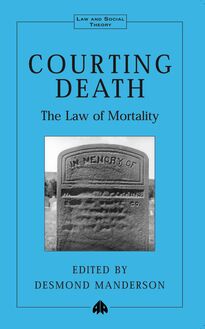Courting Death , livre ebook
244
pages
English
Ebooks
1999
Obtenez un accès à la bibliothèque pour le consulter en ligne En savoir plus
Découvre YouScribe et accède à tout notre catalogue !
Découvre YouScribe et accède à tout notre catalogue !
244
pages
English
Ebooks
1999
Obtenez un accès à la bibliothèque pour le consulter en ligne En savoir plus
Publié par
Date de parution
20 septembre 1999
EAN13
9781849640190
Langue
English
Poids de l'ouvrage
1 Mo
Introduction: Tales from the Crypt: A Metaphor, An Image, A Story
Desmond Manderson
Part One: In Extremis
1. Death as the Horizon of Law
Peter Fitzpatrick
2. Et Lex Perpetua: Dying Declarations and the Terror of Süssmayr
Desmond Manderson
3. Killing Me Softly: Capital Punishment and the Technologies for Taking Life
Austin Sarat
4. The Sanctity of Death: Poetry and the Law and Ethics of Euthanasia
Melanie Williams
Part Two: Post Mortem
5. But a Lump of Earth: The Legal Status of the Corpse
Ngaire Naffine
6. Bodily Remains in the Cemetery and the Burial Ground: A Comparative Anthropology of Law and Death
Prue Vines
7. Did He Fall or Was He Pushed? Inquiring Into Pitjantjatjara Deaths
Jon Willis
8. Pro Patria Mori: Law, Reconciliation, and the Nation
Scott Veitch
Part Three: Momento Mori
9. Law Deathbound: Antigone and the Dialectics of Nomos and Thanatos
Costas Douzinas
10. The Ethical Obligation to Show Allegiance to the Un-knowable
Marinos Diamantides
11. Stephen Dedalus’ Magic Words: Death and the Law Between James Joyce & Pierre Legendre
Adam Gearey
12. Courting Death
Peter Goodrich
Contributors’ Notes
Index
Publié par
Date de parution
20 septembre 1999
EAN13
9781849640190
Langue
English
Poids de l'ouvrage
1 Mo
